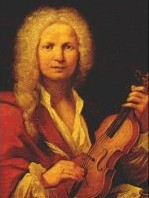Baroque Music for Concentration Vivaldi - 7 Violin Concertos 'L'imperatore' 6Antonio Lucio Vivaldi (1678 - 1741)Concerti per violino 'L'imperatore'Concertos. He 'borrowed' it from a work by a contemporary, Giovanni Maria Ruggieri. Here Vivaldi has considerably improved the original, altering the orchestration, giving a greater role to the trumpet, and condensing Ruggieri's double chorus to a single four-voice chorus.
Antonio Lucio Vivaldi (1678-1741)
Born in 1678, Antonio Lucio Vivaldi is closely associated with his native city of Venice. He studied music as a child with his father, a violinist. At the age of 15, he began to study for the priesthood, and was ordained as a Roman Catholic priest in 1703.
Antonio Vivaldi
Vivaldi spent most of his career at a single institution – the Ospedale della Pietà, a home for the illegitimate children of Venetian noblemen and courtiers. Starting as a teacher in 1703, Vivaldi had as his pupils the girls at the Ospedale, for whom music was a key part of their curriculum. Vivaldi was tasked with composing new works for every major church feast, as well as teaching music and voice, and instructing the girls to play various instruments. He proved himself to be indispensable to the school, and was given the position of maestro di concerti in 1716. Under his tenure, the Ospedale’s choir and orchestra built a strong reputation.
Vivaldi Baroque Pieces
Vivaldi wrote over 500 instrumental concertos and sacred choral works. He also composed some 40 operas, not for the school, but for public performance in Venice. Although Vivaldi remained with the Ospedale through virtually his entire life, his music became known throughout Europe. Vivaldi’s influence may have helped to lighten the darker aspects of the northern European baroque by infusing it with a joyful, Mediterranean tone.
In 1740, Vivaldi moved to Vienna. It is thought that he may have hoped to gain a position with the Austrian court, but seems to have found no success. He died in Vienna as a pauper in 1741. In a curious coincidence that illustrates the intertwined relationships throughout the baroque world, a young Franz Joseph Hayden was at this time a choir boy at St. Stephen’s Cathedral, where Vivaldi’s funeral was conducted.
At the time of his death, Vivaldi’s music was already falling out of favor and few of his compositions were available. He would be virtually ignored until after 1926, when a large cache of original manuscripts was discovered (including his now-beloved Four Seasons). Forgotten works by Vivaldi continue to appear from time to time, most recently in 2003 and 2005.

| THE FOUR SEASONS: 1: Concerto No.1 in E Major, RV 269, 'SPRING' 2: Concerto No.2 in g minor, RV 315, 'SUMMER' 3: Concerto No.3 in F Major, RV 293, 'AUTUMN' 4: Concerto No.4 in f minor, RV 297, 'WINTER' One of the earliest uses of music was in the accompaniment of theatrical dance and story-telling, so it is natural that composers should from time to time produce what we know as 'program music' – music written to portray events, activities or moods such as pastoral scenes or storms. Music representing the moods of the four seasons has always been popular, and baroque composers such as Werner and Fischer among others produced cycles of concertos representing the fours seasons. But none were to do so in such precise pictorial detail as Antonio Vivaldi in his Four Seasons concertos. As a descriptive basis for his Four Seasons, Vivaldi took four Sonnets, apparently written by himself. Each of the four sonnets is expressed in a concerto, which in turn is divided into three phrases or ideas, reflected in the three movements (fast-slow-fast) of each concerto. The published scores (by Estienne Roger of Amsterdam in 1725) are marked to indicate which musical passages are representative of which verses of the sonnet. It is advisable, at least during the first few hearings, to follow the sonnets and music together, for they are bound up with one another to an extent rarely heard in any other programmatic pieces either of the baroque period or subsequently. |
|
| ANTONIO VIVALDI (1678-1741): The FOUR SEASONS The Modena Chamber Orchestra, Leader, and solo violin, Francesco Calvi Caterina Montanari, harpsichord continuo GLORIA in D, RV 589 Mimi Coertse & Ina Dressel, sopranos / Sonja Draxler, alto Vienna Academy Chorus & State Opera Orchestra Conductor Hermann Scherchen | |
This lyrical performance by the Modena Chamber Orchestra under Maestro Calvi reflects every detail of the original sonnets.... the birds of spring, a summer storm, the peasants' revelries when the autumn harvest is completed, the chattering teeth as the winter wind blows. English text of the sonnets is enclosed with the CD. 'Four Seasons' recordings are usually accompanied on a CD by some similar string concertos. The Baroque Music Club CD however has taken the opportunity to offer something different and a complete contrast in sound, with Vivaldi's magnificent Gloria in a wonderful performance full of sensitivity and detailing. Here on one CD is something familiar, something perhaps a little less known. The Gloria will certainly prove a revelation to those unfamiliar with it. Total Time: 74:51. Click the image for full information and music samples. |
